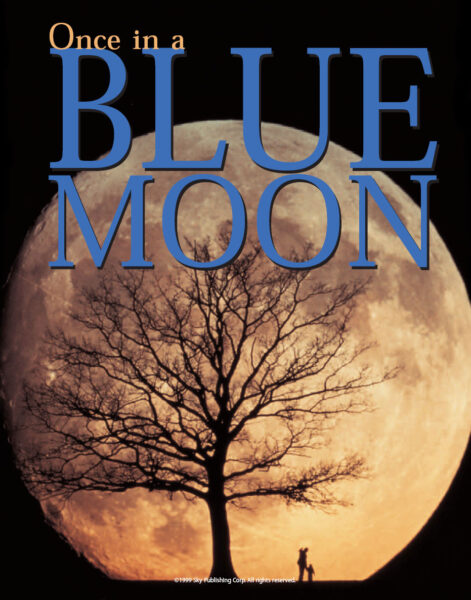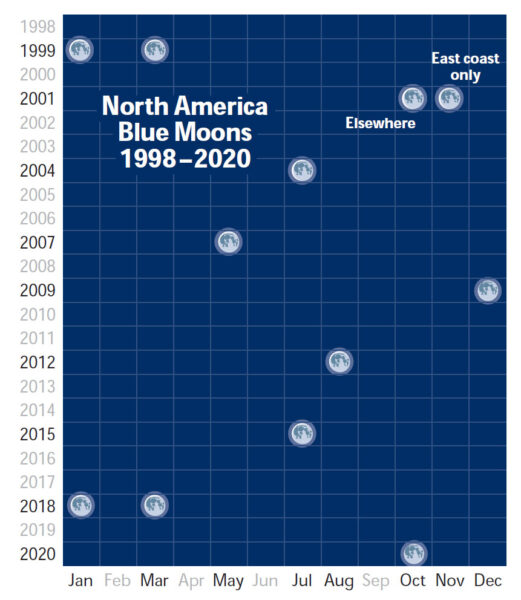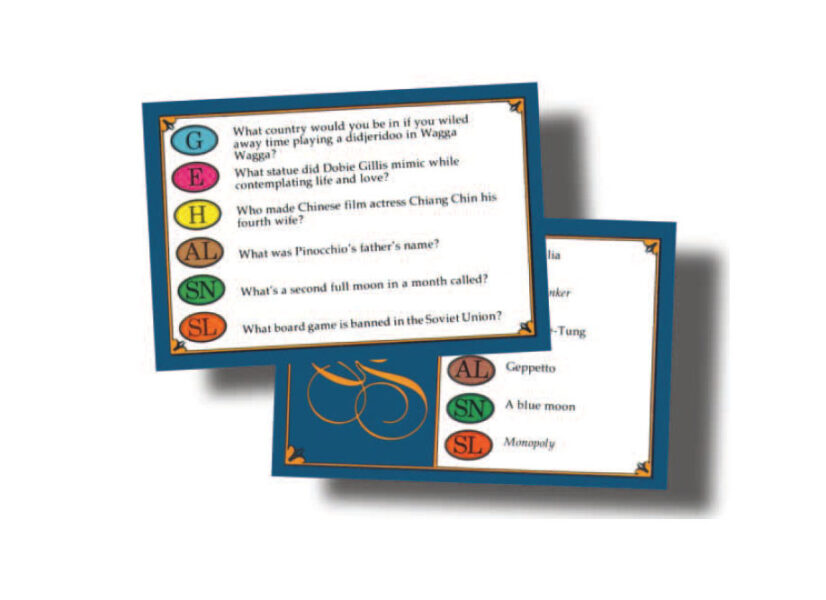You’ve probably heard the second full Moon in a month referred to as a “blue moon” — but you might be surprised at the origin of the phrase.
"According to old folklore," some people say, the second full Moon in a calendar month is called a "blue Moon." They go on to explain that this is the origin of the expression "once in a blue Moon." But it isn't true! The term "blue Moon" has been around a long time, well over 400 years, but its calendrical meaning has become widespread only in the last 25 years.
Blue Moon: A Variety of Meanings

Courtesy Franz X. Kohlhauf.
In fact, the very earliest uses of the term were remarkably like saying the Moon is made of green cheese. Both were obvious absurdities, about which there could be no doubt. "He would argue the Moon was blue" was taken by the average person of the 16th century as we take "He'd argue that black is white."
The concept that a blue Moon was absurd (the first meaning) led eventually to a second meaning, that of "never." The statement "I'll marry you, m'lady, when the Moon is blue!" would not have been taken as a betrothal in the 18th century.
But there are also historical examples of the Moon actually turning blue. That's the third meaning — the Moon appearing blue in the sky. When the Indonesian volcano Krakatoa exploded in 1883, its dust turned sunsets green and the Moon blue all around the world for the best part of two years. In 1927, the Indian monsoons were late arriving and the extra-long dry season blew up enough dust for a blue Moon. And Moons in northeastern North America turned blue in 1951 when huge forest fires in western Canada threw smoke particles up into the sky.
So, by the mid-19th century, it was clear that visibly blue Moons, though rare, did happen from time to time — whence the phrase "once in a blue Moon." It meant then exactly what it means today, a fairly infrequent event, not quite regular enough to pinpoint. That's meaning number four, and today it is still the main one.
But meaning is a slippery substance, and I know of a half dozen songs that use "blue Moon" as a symbol of sadness and loneliness. The poor crooner's Moon often turns to gold when he gets his love at the end of the song. That's meaning number five: check your old Elvis Presley or Bill Monroe records for more information.
And did I mention a slinky blue liquid in a cocktail glass, one that requires curaçao, gin, and perhaps a twist of lemon? That's number six.
The Second Full Moon in a Month

Sky & Telescope illustration
All that being said, what is a blue moon? Finally we arrive at the most recent meaning of all, the second full Moon in a month. I first heard it in 1988. At the end of May that year, when a second full Moon occurred, radio stations and newspapers everywhere carried an item on this bit of "old folklore," as they called it, drawing on an international wire story. Across North America the blue Moon caught the public's imagination. In the following months, restaurants, clothing stores, and bookstores opened under the name "Blue Moon." An artist I know did a set of night landscapes that month; he calls them his Blue Moon series. At the Memorial University of Newfoundland Folklore & Language Archive we get calls from all over, from people wondering about bits of folklore. And that month we got calls about blue Moons.
I searched high and low for an earlier example of this usage, or any other name for two full Moons in a single calendar month. But the search was in vain — this meaning seemed to have no history. I did find information on the other meanings of "blue Moon," but not this one, number seven.
Then in December 1990, with another "blue Moon" coming on, I started getting more calls and decided to write about it in the local newspaper. I searched harder this time, exhausting all the usual sources: specialized dictionaries, indexes of proverbial sayings, and regional collections of folklore. A brand-new edition of the huge Oxford English Dictionary had recently come out, but even it omitted this particular meaning. "Blue Moon" seemed to be a truly modern piece of folklore, masquerading as something old.
Still Unresolved

Sky & Telescope illustration
Then my brother-in-law reminded me that the term was a question in one of the Trivial Pursuit boxes, the Genus II edition published in 1986. I hope the manufacturer of this game is still the fine company for scholars it was then. They had kept all their files and were able to tell me their source had been a children's book published the previous year, The Kids' World Almanac of Records and Facts (New York, 1985: World Almanac Publications). Where the authors, Margo McLoone-Basta and Alice Siegel, got it, no one seemed to know.
Used in this way, the term was certainly very, very local before they included it in their book. It seemed never to have been written down before. Of course, authors sometimes "invent" information to protect themselves against plagiarists. Well, if that were the case they'd already lost, because the new "blue Moon" almost immediately entered the folklore of the modern world. It became as living a meaning as any of its predecessors.
During my search it hadn't occurred to me that radio might have played a role. My newspaper column had just gone to the printer when I got a copy of the December 1990 Astronomy. There, Deborah Byrd mentioned the term coming from a March 1946 article in Sky & Telescope (page 3). (But S&T had got it wrong, too!) Contacting her, I found out she had read it for her National Public Radio program, Star Date, in late January 1980. No doubt that's where the authors of the children's almanac heard it. Clearly, Byrd's radio broadcast got the recent "blue Moon" ball rolling.
By the way, the 1946 note, written by J. Hugh Pruett, sends the reader back to a question-and-answer column in Sky & Telescope for July 1943 (page 17). Its compiler, L. J. Lafleur, quoted the 1937 Maine Farmers' Almanac. And there the trail goes cold: I've never been able to find an earlier trace. If a reader has any other pre-1943 reference to a calendrical "blue Moon," please tell me about it. As they were 56 years ago, Sky & Telescope readers will be the first to know!
Since 1990 I've been in touch with hundreds of people suggesting the origin of meaning number seven. Two possibilities stand out, but neither has the evidence needed to nail it down. Both are still open.
One comes from a family who emigrated from Czechoslovakia to the United States three generations ago. A member of the family told me her grandparents used the term this way, and she thought they were translating from their native language, Czech. But I've checked with several native speakers of Czech and found nothing like "blue Moon."
Secondly, an e-mail correspondent told me several years ago that calendar printers would always print a full Moon in red except when it was the second one in a month; then it would be printed in blue! That sounded wonderfully plausible -— until I looked at older calendars and found none that were so.
Our new blue Moon has something of the modern times in it, a technical aspect that most of the earlier meanings lacked. Perhaps that's why it caught on so quickly. It appeals to our modern sensibilities, including our desire to have plausible origins. But any folklorist will tell you that plausibility is the mantle that folklore wears to sneak through history's lines. "Old folklore" it is not, but real folklore it is. Given its present popularity, it may last a long time.
Time Line: Blue Moon As Second Full Moon in a Month
Before 1930. Maybe a custom of calendar printers; maybe a Czech tradition.
1937. An obscure Maine Farmers' Almanac uses term "blue Moon" for certain full Moons (though not for the second one in a given month).
1943. L. J. Lafleur quotes the Maine almanac in a Sky & Telescope quiz column.
1946. Citing Lafleur's column and the almanac, J. Hugh Pruett in Sky & Telescope gives the second-full- Moon interpretation.
January 1980. Deborah Byrd used it in her National Public Radio program, Star Date, the widest exposure of the new meaning so far.
1985. The Kids' World Almanac spreads meaning further.
1986. Included in Trivial Pursuit.
May 1988. International press coverage piques the public's interest; the term receives its greatest exposure ever.
December 1990. The decade of the 1980s ends on a New Year's Eve blue Moon.
Some Songs with Blue Moons
Richard Rodgers and Lorenz Hart's Blue Moon, 1934, popularized by Elvis Presley and others.
Bill Monroe, Blue Moon of Kentucky, 1944.
Wiley Walker and Gene Sullivan's When My Blue Moon Turns to Gold Again, sung by Eddy Arnold (among others).
Roseanne Cash, Blue Moon with Heartache, 1982.
Nanci Griffith, Once in a Very Blue Moon, 1984.
Toby Keith, Does That Blue Moon Ever Shine on You? 1987.
Whiskey Rose, Blue Moon Over Heaven, 1998.
 2
2









Comments
Once in a blue moon
December 20, 2016 at 10:02 am
I just love to read this article about once in a blue moon, really such a wonderful stuff can be found only once in a blue moon. Loved it, thanks.
Ruth, UK
You must be logged in to post a comment.
edburkhead
January 31, 2018 at 9:20 pm
Ah! However, if there’s a lot of dust in the air, the blue light (being of shorter wave length) is more likely to be bent. That can happen with dust or water droplets in the air. That’s why the sky is blue instead of space black.
Similarly, when the sun is just rising or setting it looks red, not blue. The blue light has been scattered by the dust/water droplets and only the longer wave length red light makes it to your eyes.
Thus, at times when there’s more dust or water droplets in the air, the objects like the moon are more likely to be red, not blue.
Maybe, when there’s NO dust in the air AND the people came out from 3600°K inside lights or from even lower temperature candles, the moon (which is in full sunlight at 5600°K) WILL look blue. I’d bet the people running the camera for the TV station fiddled with the color temperature of their camera till the moon was the specified color. (I’s easy to do, after all. I had the wrong color temperature set on my camera in a couple of embarrassing incidents and it was a pain to fix it!)
The moon only has normal “sun” color temperature. It can only look “sun” or daylight colored, which, could be mistaken for blue because of human physiology and camera setup.
Ed
You must be logged in to post a comment.
You must be logged in to post a comment.